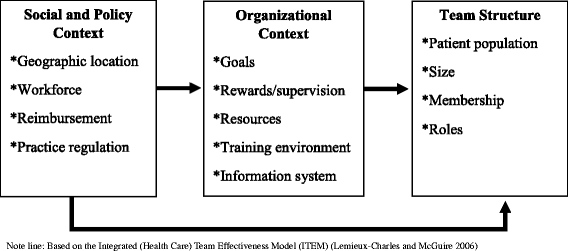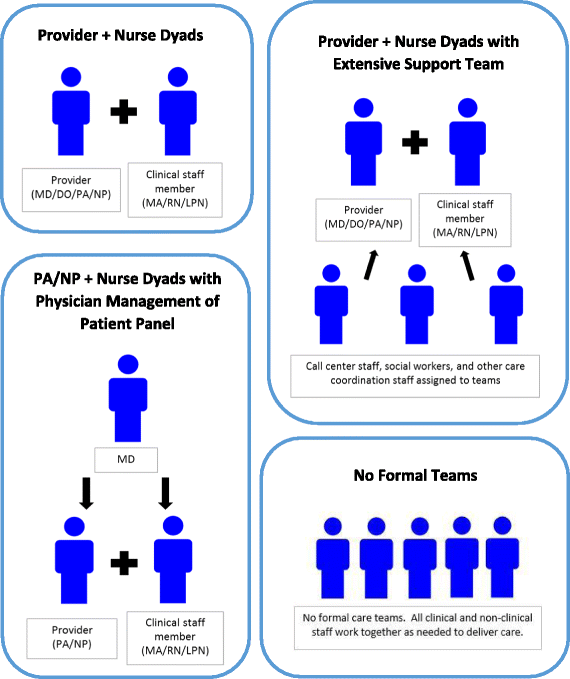Primary care multidisciplinary teams in practice: a qualitative study
- PMID: 29284409
- PMCID: PMC5747144
- DOI: 10.1186/s12875-017-0701-6
Primary care multidisciplinary teams in practice: a qualitative study
Abstract
Background: Current recommendations for strengthening the US healthcare system consider restructuring primary care into multidisciplinary teams as vital to improving quality and efficiency. Yet, approaches to the selection of team designs remain unclear. This project describes current primary care team designs, primary care professionals' perceptions of ideal team designs, and perceived facilitating factors and barriers to implementing ideal team-based care.
Methods: Qualitative study of 44 health care professionals at 6 primary care practices in North Carolina using focus group discussions and surveys. Data was analyzed using framework content analysis.
Results: Practices used a variety of multidisciplinary team designs with the specific design being influenced by the social and policy context in which practices were embedded. Practices overwhelmingly located barriers to adopting ideal multidisciplinary teams as being outside of their individual practices and outside of their control. Participants viewed internal organizational contexts as the major facilitators of multidisciplinary primary care teams. The majority of practices described their ideal team design as including a social worker to meet the needs of socially complex patients.
Conclusions: Primary care multidisciplinary team designs vary across practices, shaped in part by contextual factors perceived as barriers outside of the practices' control. Facilitating factors within practices provide a culture of support to team members, but they are insufficient to overcome the perceived barriers. The common desire to add social workers to care teams reflects practices' struggles to meet the complex demands of patients and external agencies. Government or organizational policies should avoid one-size-fits-all approaches to multidisciplinary care teams, and instead allow primary care practices to adapt to their specific contextual circumstances.
Keywords: Patient care team; Primary care; Qualitative research.
Conflict of interest statement
Ethics approval and consent to participate
This study was approved by the Duke University Health System Institutional Review Board (IRB) (Pro00060484); and informed, written consent was obtained from all participants.
Consent for publication
Not applicable.
Competing interests
The authors declare that they have no competing interests.
Publisher’s Note
Springer Nature remains neutral with regard to jurisdictional claims in published maps and institutional affiliations.
Figures
Similar articles
-
Who is on the primary care team? Professionals' perceptions of the conceptualization of teams and the underlying factors: a mixed-methods study.BMC Fam Pract. 2017 Dec 28;18(1):111. doi: 10.1186/s12875-017-0685-2. BMC Fam Pract. 2017. PMID: 29281980 Free PMC article.
-
Exploring the barriers and facilitators of psychological safety in primary care teams: a qualitative study.BMC Health Serv Res. 2021 Mar 24;21(1):269. doi: 10.1186/s12913-021-06232-7. BMC Health Serv Res. 2021. PMID: 33761958 Free PMC article.
-
The role of the general practitioner in multidisciplinary teams: a qualitative study in elderly care.BMC Fam Pract. 2018 Mar 10;19(1):40. doi: 10.1186/s12875-018-0726-5. BMC Fam Pract. 2018. PMID: 29523092 Free PMC article.
-
Perceived Barriers, Benefits, Facilitators, and Attitudes of Health Professionals Towards Multidisciplinary Team Care in Type 2 Diabetes Management: A Systematic Review.Curr Diabetes Rev. 2021;17(6):e111020187812. doi: 10.2174/1573399816999201110200126. Curr Diabetes Rev. 2021. PMID: 33176659
-
What fosters or prevents interprofessional teamworking in primary and community care? A literature review.Int J Nurs Stud. 2008 Jan;45(1):140-53. doi: 10.1016/j.ijnurstu.2007.01.015. Epub 2007 Mar 26. Int J Nurs Stud. 2008. PMID: 17383655 Review.
Cited by
-
Demographic, practice and clinical management characteristics of osteopaths referring to podiatrists: secondary analysis of a nationally representative sample of Australian osteopaths.BMC Health Serv Res. 2022 Feb 18;22(1):224. doi: 10.1186/s12913-022-07520-6. BMC Health Serv Res. 2022. PMID: 35180867 Free PMC article.
-
Improving healthcare quality by unifying the American electronic medical report system: time for change.Egypt Heart J. 2024 Mar 15;76(1):32. doi: 10.1186/s43044-024-00463-9. Egypt Heart J. 2024. PMID: 38489094 Free PMC article.
-
The case for integrating genetic counselors into primary care: A paradigm shift for our profession.J Genet Couns. 2025 Jun;34(3):e70051. doi: 10.1002/jgc4.70051. J Genet Couns. 2025. PMID: 40349148 Free PMC article.
-
Improving the quality of patient care in lung cancer: key factors for successful multidisciplinary team working.Explor Target Antitumor Ther. 2024;5(2):260-277. doi: 10.37349/etat.2024.00217. Epub 2024 Mar 21. Explor Target Antitumor Ther. 2024. PMID: 38751383 Free PMC article. Review.
-
Facilitation of team-based care to improve HTN management and outcomes: a protocol for a randomized stepped wedge trial.BMC Health Serv Res. 2023 May 31;23(1):560. doi: 10.1186/s12913-023-09533-1. BMC Health Serv Res. 2023. PMID: 37259081 Free PMC article.
References
-
- Davis K, Stremikis K, Squires D, Schoen C. Mirror, mirror on the wall. CommonWealth Fund: How the performance of the US Health care system compares internationally New York; 2014.
-
- Institute of Medicine . Primary care: America's health in a new era. Washington, D.C.: National Academy Press; 1996.
-
- Center for Workforce Studies (AAMC). Physician Shortages to Worsen Without Increases in Residency Training. AAMC 2010 June.
Publication types
MeSH terms
LinkOut - more resources
Full Text Sources
Other Literature Sources



